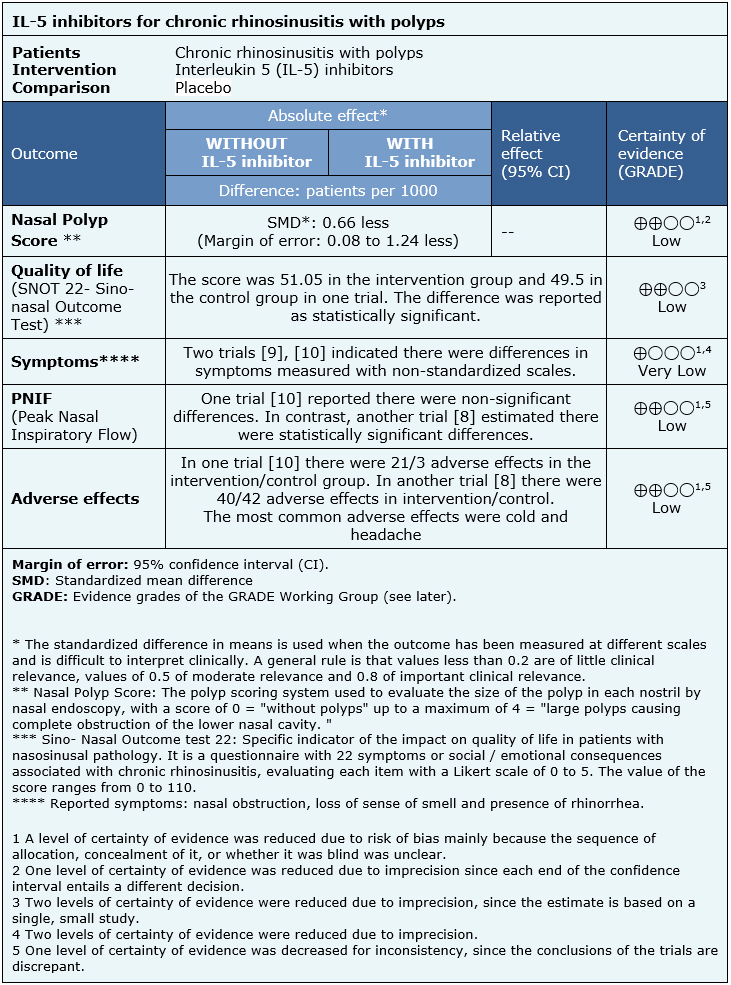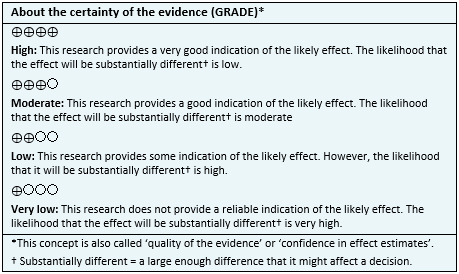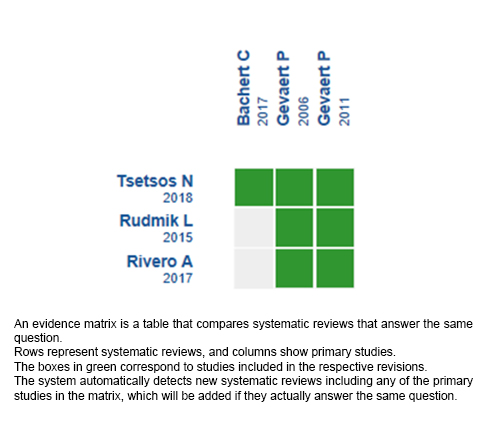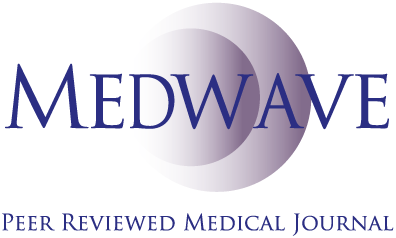Epistemonikos summaries
← vista completaPublished on October 24, 2018 | http://doi.org/10.5867/medwave.2018.06.7300
Anti-interleukin 5 therapy for chronic rhinosinusitis with polyps
Terapia anti interleukina 5 para la rinosinusitis crónica con pólipos
Abstract
INTRODUCTION Chronic rhinosinusitis is the inflammation of sinonasal mucosa lasting longer than 12 weeks. Two clinical forms are distinguished: chronic rhinosinusitis with polyps and without polyps. Patients with chronic rhinosinusitis with polyps exhibit high levels of interleukin 5, which promotes differentiation and survival of eosinophils. So, minimizing their circulation has been proposed as a new treatment strategy. However, there is no clarity regarding its real effectiveness.
METHODS To answer this question we used Epistemonikos, the largest database of systematic reviews in health, which is maintained by screening multiple information sources, including MEDLINE, EMBASE, Cochrane, among others. We extracted data from the systematic reviews, reanalyzed data of primary studies, conducted a meta-analysis and generated a summary of findings table using the GRADE approach.
RESULTS AND CONCLUSIONS We identified three systematic reviews included three primary studies overall, all corresponding to randomized trials. We concluded inhibitors of interleukin 5 might decrease nasal polyps score. Although they might be associated with adverse effects, these would be infrequent and of low severity. However, the certainty of the evidence is low.
Problem
Chronic rhinosinusitis is a chronic inflammatory disease of the sinonasal mucosa lasting longer than 12 weeks. It is estimated that 11.9% and 10.9% of the general population of the United States and Europe, respectively, have chronic rhinosinusitis [1],[2] whose symptoms significantly reduce physical and psychological well-being, affecting quality of life.
Medical treatment traditionally includes nasal washes and topical corticosteroids as maintenance therapy; systemic corticosteroids and antibiotics for exacerbations, and functional endoscopic surgery of paranasal cavities when medical and pharmacological treatment is not effective. However, there are many patients who do not respond or respond partially to treatment. One potential explanation is it focus on the relief of symptoms and reduction of inflammation rather than the cause of the disease.Interleukin 5 is a key mediator of chemotaxis, differentiation, activation and survival of the eosinophils [3]. Inhibiting this pathway would stop the release of toxic products that lead to more and lasting inflammation and formation of polyps in patients with chronic rhinosinusitis [4]. However, it is unclear what are the clinical effects of biological drugs that inhibit circulating interleukin 5, such as mepolizumab or reslizumab.
Methods
To answer the question, we used Epistemonikos, the largest database of systematic reviews in health, which is maintained by screening multiple information sources, including MEDLINE, EMBASE, Cochrane, among others, to identify systematic reviews and their included primary studies. We extracted data from the identified reviews and reanalyzed data from primary studies included in those reviews. With this information, we generated a structured summary denominated FRISBEE (Friendly Summary of Body of Evidence using Epistemonikos) using a pre-established format, which includes key messages, a summary of the body of evidence (presented as an evidence matrix in Epistemonikos), meta-analysis of the total of studies when it is possible, a summary of findings table following the GRADE approach and a section of other considerations for decision-making.
|
Key messages
|
About the body of evidence for this question
|
What is the evidence. |
We found three systematic reviews [5],[6],[7] that included three primary studies [8],[9],[10], all of which were randomized trials. |
|
What types of patients were included* |
All trials [8],[9],[10] included patients older than 18 years. Two trials [9],[10] included patients with a history of chronic rhinosinusitis and nasal polyps (grade 3 or 4) with failure to standard medical therapy or patients with recurrent nasal polyps after surgery (grade 1-4). One trial included patients with severe recurrent bilateral nasal polyposis who required surgery after failure of standard corticosteroid therapy [8]. |
|
What types of interventions were included* |
All trials used interleukin 5 inhibitors: one trial [9] used reslizumab and two trials [8],[10] mepolizumab.Reslizumab was used in doses of 3 mg/kg and 1 mg/kg in a single dose. Mepolizumab was administered in two doses of 750 mg IV separated by 28 days in one trial [10] and in six doses of 750 mg IV separated by 4 weeks in the other [8]. |
|
What types of outcomes |
The trials evaluated multiple outcomes, which were grouped by the systematic reviews as follows:
The average follow-up was 36 weeks, with a range between 25 and 48 weeks. |
* The information about primary studies is extracted from the systematic reviews identified, unless otherwise specified.
Summary of findings
The information on the effects of interleukin 5 inhibitors is based on three randomized trials[8],[9],[10] that included 159 patients.
Two trials [9],[10] measured the Nasal Polyp Score and symptoms through questions aboutspecific symptoms, such as nasal obstruction, loss of sense of smell and presence ofrhinorrhea (54 patients). Two trials [8],[10] reported Peak nasal inspiratory flow and adverse effects (135 patients). Only one trial [8] evaluated quality of life using the SNOT-22 specific indicator (105 patients).
The summary of findings is as follows:
- Inhibitors of interleukin 5 might decrease the score of nasal polyps, but the certainty of the evidence is low.
- Inhibitors of interleukin 5 might not have an impact on quality of life measured in SNOT, but the certainty of the evidence is low.
- It is not clear whether interleukin 5 inhibitors reduce symptoms (nasal obstruction, loss of sense of smell and presence of rhinorrhea) because the certainty of the evidence is very low.
- Inhibitors of interleukin 5 might improve PNIF, but the certainty of the evidence is low.
- Inhibitors of interleukin 5 might be associated to adverse effects of low frequency and severity, but the certainty of the evidence is low.

| Follow the link to access the interactive version of this table (Interactive Summary of Findings – iSoF) |

Other considerations for decision-making
|
To whom this evidence does and does not apply |
|
| About the outcomes included in this summary |
|
| Balance between benefits and risks, and certainty of the evidence |
|
| Resource considerations |
|
| What would patients and their doctors think about this intervention |
|
|
Differences between this summary and other sources |
|
| Could this evidence change in the future? |
|
How we conducted this summary
Using automated and collaborative means, we compiled all the relevant evidence for the question of interest and we present it as a matrix of evidence.

Follow the link to access the interactive version: Anti IL5 for chronic rhinosinusitis with polyps.
Notes
The upper portion of the matrix of evidence will display a warning of “new evidence” if new systematic reviews are published after the publication of this summary. Even though the project considers the periodical update of these summaries, users are invited to comment in Medwave or to contact the authors through email if they find new evidence and the summary should be updated earlier.
After creating an account in Epistemonikos, users will be able to save the matrixes and to receive automated notifications any time new evidence potentially relevant for the question appears.
This article is part of the Epistemonikos Evidence Synthesis project. It is elaborated with a pre-established methodology, following rigorous methodological standards and internal peer review process. Each of these articles corresponds to a summary, denominated FRISBEE (Friendly Summary of Body of Evidence using Epistemonikos), whose main objective is to synthesize the body of evidence for a specific question, with a friendly format to clinical professionals. Its main resources are based on the evidence matrix of Epistemonikos and analysis of results using GRADE methodology. Further details of the methods for developing this FRISBEE are described here (http://dx.doi.org/10.5867/medwave.2014.06.5997)
Epistemonikos foundation is a non-for-profit organization aiming to bring information closer to health decision-makers with technology. Its main development is Epistemonikos database (www.epistemonikos.org).
Potential conflicts of interest
The authors do not have relevant interests to declare.

